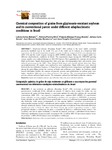Use este identificador para citar ou linkar para este item:
http://www.alice.cnptia.embrapa.br/alice/handle/doc/1069889| Título: | Chemical composition of grains from glyphosate-resistant soybean and its conventional parent under different edaphoclimatic conditions in Brazil. |
| Autoria: | BABUJIA, L. C.  SILVA, A. P.   BIONDO, P. B. F.   GARCIA, J. C.   MANDARINO, J. M. G.   VISENTAINER, J. V.   |
| Afiliação: | LETÍCIA CARLOS BABUJIA, CNPq; ADRIANA PEREIRA SILVA; POLYANA BATOQUI FRANÇA BIONDO, CNPq; JULIANA CARLA GARCIA, CNPq; JOSE MARCOS GONTIJO MANDARINO, CNPSO; JESUI VERGILIO VISENTAINER, CNPq. |
| Ano de publicação: | 2015 |
| Referência: | Acta Scientiarum. Agronomy, Maringá, v. 37, n. 4, p. 463-471, Oct.-Dec. 2015. |
| Conteúdo: | ABSTRACT: Glyphosate-tolerant (Roundup Ready®, RR) soybean is the most widely cultivated genetically modified crop in the world. The aim of this study was to evaluate, in a long-term field experiment, the chemical composition of grains in a pair of cultivars composed of the conventional parent (BRS 133) and the nearly isogenic transgenic (BRS 245RR) soybean. Plants were cropped under two different edaphoclimatic conditions in Brazil. The experiments began during the 2003/2004 growing season; samples were collected during the 2011/2012 harvest. Were quantified the contents of isoflavones (high performance liquid chromatography), fatty acids (gas chromatography), lipid and proteins (near infrared spectroscopy in the NIR - Near Infrared Reflectance) and minerals (atomic absorption flame spectrophotometry). All samples were analyzed in three replications. Major differences were observed between the two cultivation locations. In Ponta Grossa, which has lower temperatures and higher rainfall during the grain filling period, the contents of lipids and isoflavones were higher. In Londrina, which hassoil with higher fertility, the contents of minerals, proteins and carbohydrates in soybean grains were higher. Significant differences were observed between the cultivars. The conventional parent had higher protein contents and lower lipid contents. The transgenic soybean line had higher isoflavone contents. RESUMO: soja resistente ao glifosato (Roundup Ready®, RR) representa a principal cultura geneticamente modificada (GM) cultivada no mundo. O objetivo deste estudo foi avaliar, em um experimento de campo de longa duração, a composição química dos grãos das cultivares de soja parental foram realizados em duas condições edafoclimáticas distintas e tiveram início em 2003/2004 e as amostras foram coletadas na safra 2011/2012. Foram quantificados os teores de isoflavonas (cromatografia líquida de alta eficiência), ácidos graxos (cromatografia em fase gasosa), lipídeos e proteínas (espectroscopia no infravermelho próximo na NIR - refletância de infravermelho próximo) e minerais (espectrofotometria de absorção atômica de chama). Todas as amostras foram analisadas em triplicata. Foram observadas diferenças significativas entre os locais de cultivo. Em Ponta Grossa, que possui temperaturas menores e maior precipitação durante o enchimento de grãos, o conteúdo de lipídeos e isoflavonas foram maiores. Em Londrina, com solo de maior fertilidade, o conteúdo de minerais, proteínas e carboidratos foram maiores. Diferenças significativas foram associadas ao transgene RR. A cultivar BRS 133 apresentou maiores teores de proteínas e a BRS 245 RR maiores teores de lipídeos e isoflavonas. |
| Thesagro: | Grão Soja |
| Palavras-chave: | Transgênico |
| ISSN: | 1807-8621 |
| Digital Object Identifier: | 10.4025/actasciagron.v37i4.25108 |
| Tipo do material: | Artigo de periódico |
| Acesso: | openAccess |
| Aparece nas coleções: | Artigo em periódico indexado (CNPSO)  |
Arquivos associados a este item:
| Arquivo | Descrição | Tamanho | Formato | |
|---|---|---|---|---|
| 251081288481PB.pdf | 734,67 kB | Adobe PDF |  Visualizar/Abrir |









